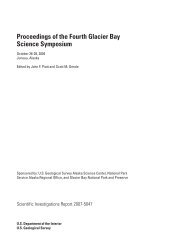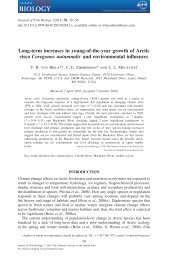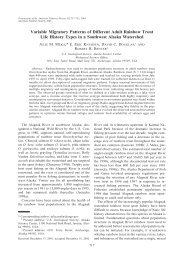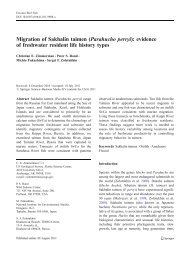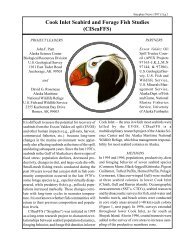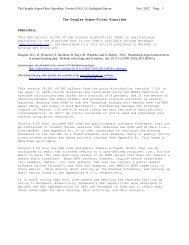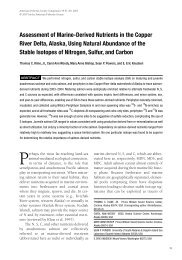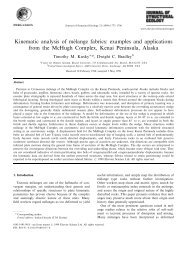Mexican native trouts: a review of their history and ... - Webspace
Mexican native trouts: a review of their history and ... - Webspace
Mexican native trouts: a review of their history and ... - Webspace
You also want an ePaper? Increase the reach of your titles
YUMPU automatically turns print PDFs into web optimized ePapers that Google loves.
304<br />
The upper watersheds <strong>of</strong> the Mayo, Sinaloa <strong>and</strong><br />
Culiacán drainages, <strong>and</strong> particularly the Fuerte <strong>and</strong><br />
Conchos watersheds, unlike other drainages discussed<br />
here, are home to the Tarahumara (or Rarámuri)<br />
<strong>and</strong> the Tepehuanes. These indigenous peoples have<br />
populated the area for many centuries longer than have<br />
mestizo populations. Many Tarahumara still practice<br />
<strong>their</strong> ancestral lifestyle <strong>of</strong> extensive dry farming,<br />
primarily <strong>of</strong> corn <strong>and</strong> beans, <strong>and</strong> extensive grazing,<br />
primarily <strong>of</strong> goats (Bergtold, 1991; Fontana, 1979;<br />
Lumholtz, 1902; Pennington, 1963; Raat <strong>and</strong> Janecek,<br />
1996; Sheridan <strong>and</strong> Nash, 1979). The Tepehuanes<br />
lived a similar existence until recently when most<br />
were integrated into the forestry industry (Molinari<br />
<strong>and</strong> Nolasco, 1992). As compared to mestizos,<br />
who graze mostly cattle, focus <strong>their</strong> more intensive<br />
agriculture in river bottoms along larger watercourses,<br />
<strong>and</strong> live in larger towns, the Tarahumara (<strong>and</strong><br />
formerly Tepehuanes) are relatively evenly distributed<br />
over this very remote area, living in diffuse, small<br />
family groups <strong>and</strong> small multi-family communities.<br />
The impacts <strong>of</strong> these culturally diverse populations<br />
inhabiting much <strong>of</strong> the range <strong>of</strong> <strong>native</strong> <strong>trouts</strong> in the<br />
Sierra Madre Occidental are thus very different from<br />
one another, <strong>and</strong> any impacts associated with the<br />
traditional Tarahumara <strong>and</strong> Tepehuan cultures have<br />
been present for far longer than have those <strong>of</strong> mestizo<br />
populations. In our experience, Tarahumara-occupied<br />
high country is typically quite overgrazed, with highly<br />
eroded watersheds drained by streams flowing over<br />
bedrock or highly silted large-rock bottoms with little<br />
riparian vegetation or other cover. In much <strong>of</strong> the<br />
core Tarahumara area, peak logging activity occurred<br />
decades ago, <strong>and</strong> is not now as prominent as it is<br />
elsewhere, such as in the Durango highl<strong>and</strong>s or in<br />
much <strong>of</strong> the Río Yaqui basin.<br />
Human exploitation <strong>of</strong> fishes. While Lumholtz (1902)<br />
reported fishing with dynamite over a century ago,<br />
<strong>and</strong> we have heard <strong>of</strong> it still being used in the region,<br />
we believe it is not common within the probable<br />
range <strong>of</strong> <strong>trouts</strong>, <strong>and</strong> have not witnessed its impacts.<br />
In the uppermost Río Urique (Fuerte) <strong>and</strong> Conchos<br />
basins, however, our interviews with locals revealed<br />
that ichthyotoxic extracts <strong>of</strong> <strong>native</strong> plants have long<br />
been used to harvest fishes, <strong>and</strong> some <strong>of</strong> us (DAH,<br />
HEP) have seen first-h<strong>and</strong> evidence <strong>of</strong> <strong>their</strong> use.<br />
The impacts <strong>of</strong> fishing with toxins in flowing waters<br />
likely extend over greater distances than do impacts<br />
<strong>of</strong> dynamite, <strong>and</strong> this practice may therefore have<br />
significant impacts on fish populations.<br />
Non-<strong>native</strong> fishes. Fish culture in Mexico, including<br />
rainbow trout, dates to the 19th century (Cházari,<br />
1884; Secretaría de Fomento, 1892), but through very<br />
nearly the end <strong>of</strong> that century (<strong>and</strong> even then) it was<br />
focused in the Mexico City area until, just as logging<br />
opened new areas to grazing, it also improved access<br />
for introductions <strong>of</strong> non-<strong>native</strong> fishes into formerly<br />
remote areas. Promotion <strong>of</strong> non-<strong>native</strong> fisheries development<br />
projects in Mexico can be traced back to the<br />
late 1800s (Cházari, 1884; Secretaría de Fomento,<br />
1892), but activity increased with projects initiated<br />
by the administration <strong>of</strong> President Lazaro Cardenas in<br />
the 1930s (Simonian, 1995). Numerous rustic rainbow<br />
trout grow-out facilities were being built on streams in<br />
formerly remote areas <strong>of</strong> our study area by the 1960s<br />
<strong>and</strong> 1970s, including considerable activity in the<br />
Sierra Tarahumara area (ríos Conchos, Mayo, Fuerte)<br />
(Rosas, 1976; Sevilla, 1960). Trout species listed as in<br />
use in <strong>Mexican</strong> fish culture in the 1970s were “Salmo<br />
gairdneri var. Kamloops (“trucha Kamloops”), Salmo<br />
gairdneri var. arco-iris (“trucha arcoiris”), Salvelinus<br />
fontinalis (“trucha de arroyo”), <strong>and</strong>, interestingly, the<br />
‘<strong>native</strong> <strong>trouts</strong>’ “Salmo clarkii y Salmo chrysogaster”<br />
(Rosas, 1976). Of course, voucher specimens from<br />
the introduced stocks mentioned by Rosas were not<br />
taken, <strong>and</strong> we have no way to assess the accuracy <strong>of</strong><br />
his identifications. We are, however, certain that fish<br />
culture activities will increase in the area in the near<br />
future, as state <strong>of</strong>fices <strong>of</strong> the federal agency SEGARPA<br />
(formerly under SEMARNAT) <strong>and</strong> other development<br />
groups (Bosque Modelo Chihuahua A.C., 2001;<br />
Torres G. et al., 1997), promote it as a rural economic<br />
development tool. Obviously, presence <strong>of</strong> non-<strong>native</strong><br />
fishes, <strong>and</strong> particularly non-<strong>native</strong> <strong>trouts</strong>, in streams<br />
<strong>of</strong> this area present risks <strong>of</strong> disease, competition,<br />
<strong>and</strong> hybridization to the <strong>native</strong> <strong>trouts</strong>. As this paper<br />
was in final revisions, M.V.Z. Gerardo Zamora, <strong>of</strong><br />
SEGARPA’s El Zarco hatchery near Mexico City, notified<br />
us that Infectious Pancreatic Necrosis had been<br />
recently documented in hatcheries in the country <strong>and</strong><br />
that contaminated stocks had apparently already been<br />
sent to culture facilities within the ranges <strong>of</strong> <strong>native</strong><br />
<strong>trouts</strong>.<br />
Non-<strong>native</strong> trout introductions in Mexico<br />
Origins <strong>of</strong> <strong>Mexican</strong> hatchery rainbows. Information<br />
on the origins <strong>of</strong> <strong>Mexican</strong> hatchery strains <strong>of</strong> rainbows<br />
may be useful to future genetic studies in which introgression<br />
<strong>of</strong> <strong>native</strong> <strong>and</strong> hatchery stocks may confound<br />
interpretations. The earliest documentation that we<br />
find <strong>of</strong> importation <strong>of</strong> rainbow trout to Mexico comes




